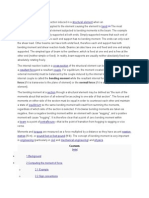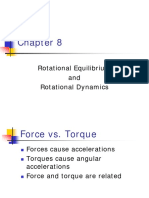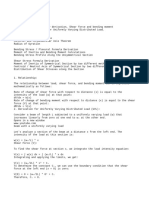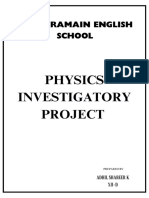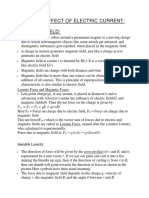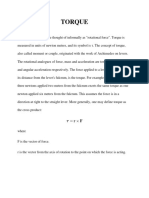Moment of Force
Moment of Force
Uploaded by
Ambuj JainCopyright:
Available Formats
Moment of Force
Moment of Force
Uploaded by
Ambuj JainCopyright
Available Formats
Share this document
Did you find this document useful?
Is this content inappropriate?
Copyright:
Available Formats
Moment of Force
Moment of Force
Uploaded by
Ambuj JainCopyright:
Available Formats
Moment of force (often just moment) is the tendency of a force to twist or rotate an object; see the article torque
for details. This is an important, basic concept in engineering and physics. (Note: In mechanical and civil engineering, "moment" and "torque" have different meanings, while in physics they are synonyms. See the discussion in the "torque" article, or the article couple (mechanics).) o Moment arm is a quantity used when calculating moments of force. See the article torque. o The Principle of moments is a theorem concerning moments or force. See the article torque. o A pure moment is a special type of moment of force. See the article couple (mechanics). Moment of a vector is a generalization of the moment of force. The moment M of a vector B about the point A is
where is the vector from point A to the position where quantity B is applied. represents the cross product of the vectors. Thus M can be referred to as "the moment M with respect to the axis that goes through the point A", or simply "the moment M around A". If A is the origin, or, informally, if the axis involved is clear from context, one often omits A and says simply moment. When B is the force, the moment of force is the torque as defined above.
Moment of inertia (
) is analogous to mass in discussions of rotational motion. ) is the rotational analog of
Moment of momentum or angular momentum ( momentum.
Magnetic moment ( ) is a dipole moment measuring the strength and direction of a magnetic source. Electric dipole moment is a dipole moment measuring the charge difference and direction between two or more charges. For example, the electric dipole moment between a change of -q and q separated by a distance of d is ( )
You might also like
- Chapter 1 - Shear Forces and Bending MomentsNo ratings yetChapter 1 - Shear Forces and Bending Moments27 pages
- Simple Harmonic Motion and Free VibrationNo ratings yetSimple Harmonic Motion and Free Vibration25 pages
- Simple Harmonic Motion and Free VibrationNo ratings yetSimple Harmonic Motion and Free Vibration25 pages
- Engineering Physics Notes I and II Semester (Common For Allbranches)No ratings yetEngineering Physics Notes I and II Semester (Common For Allbranches)113 pages
- Rotational Equilibrium and Rotational DynamicsNo ratings yetRotational Equilibrium and Rotational Dynamics49 pages
- Chapitre 5 Mecanic of Solid Ang Ok Students Corr (1)No ratings yetChapitre 5 Mecanic of Solid Ang Ok Students Corr (1)13 pages
- Oblique Shock: Two Dimensional Supersonic FlowsNo ratings yetOblique Shock: Two Dimensional Supersonic Flows25 pages
- Revision: Previous Lecture Was About Applications of Euler-Lagrange Equations Euler-Lagrange Equations (Different Forms)No ratings yetRevision: Previous Lecture Was About Applications of Euler-Lagrange Equations Euler-Lagrange Equations (Different Forms)24 pages
- Moment of Inertia of Mass, or The Angular Mass, (SI Units KG M ) Is A Measure of An Object's Resistance ToNo ratings yetMoment of Inertia of Mass, or The Angular Mass, (SI Units KG M ) Is A Measure of An Object's Resistance To5 pages
- Chapter 6-MOmentum Analysis of Flow SystemsNo ratings yetChapter 6-MOmentum Analysis of Flow Systems49 pages
- U3 Moment of Interia Introduction and NumericalsNo ratings yetU3 Moment of Interia Introduction and Numericals41 pages
- Introduction to Classical Mechanics - Lecture NotesNo ratings yetIntroduction to Classical Mechanics - Lecture Notes65 pages
- EE208 Chapter 1 Magnetic Circuits and Magnetic Materials.: 1. Basic Concepts of Electrical MachinesNo ratings yetEE208 Chapter 1 Magnetic Circuits and Magnetic Materials.: 1. Basic Concepts of Electrical Machines20 pages
- Phypuc2notes 69 8911 230529025538 C9fe2ff5No ratings yetPhypuc2notes 69 8911 230529025538 C9fe2ff521 pages
- Oscillations: 15.1. Simple Harmonic MotionNo ratings yetOscillations: 15.1. Simple Harmonic Motion13 pages
- CBSE Class 11 Physics Chapter 14 Oscillations Revision NotesNo ratings yetCBSE Class 11 Physics Chapter 14 Oscillations Revision Notes54 pages
- Mathematical Modeling of Control System Assignment NewNo ratings yetMathematical Modeling of Control System Assignment New8 pages
- 19ges28 - Engineering Mechanics: DR S.Sudhagar M.E., PHDNo ratings yet19ges28 - Engineering Mechanics: DR S.Sudhagar M.E., PHD71 pages
- Intensity of Electromagnetic Waves as a Function of Frequency, Source Distance and Aperture AngleFrom EverandIntensity of Electromagnetic Waves as a Function of Frequency, Source Distance and Aperture AngleNo ratings yet
- CAIIB ABM Sample Questions by Murugan For July 2016No ratings yetCAIIB ABM Sample Questions by Murugan For July 2016416 pages



